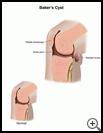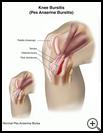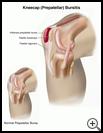
Knee Bursitis
________________________________________________________________________
KEY POINTS
- Bursitis is irritation and swelling a fluid-filled sac that acts as a cushion between bone and other tissues, such as skin, muscle, tendons, or ligaments. There are several bursae in the knee: over your kneecap, at the back of your knee, and inside your knee joint.
- Treatment may include wearing a compression wrap, removing fluid from the swollen area with a needle and syringe, medicine, or surgery.
- You may need to cut back on or stop doing activities that cause pain. Warm-up exercises and stretching before activities can help prevent injuries.
________________________________________________________________________
What is knee bursitis?
Bursitis is irritation and swelling of a bursa. A bursa is a fluid-filled sac that acts as a cushion between bone and other tissues, such as skin, muscle, tendons, or ligaments. Tendons are strong bands of tissue that attach muscle to bone. Ligaments are strong bands of tissue that connect one bone to another to form the joints.
There are several bursae in the knee: over your kneecap, at the back of your knee, and inside your knee joint.
A bursa that is only mildly irritated may improve within a few weeks with treatment. A bursa that is very swollen and irritated, or has been painful for a long time, may take months to improve.
What is the cause?
Common causes include:
- Injury to your knee, for example, from a fall
- Overuse injuries of your knee during sports, work, or hobbies. For example, bursitis on the inner side of your knee just below the joint is common in swimmers who do the breaststroke. Bursitis in front of your kneecap is common in wrestlers, or people who are often on their knees to clean floors, lay carpet, or roof houses.
- Infection from a cut or a scrape on the skin over a bursa
Bursitis located at the back of your knee, also called a Baker's cyst, may be caused by:
- Arthritis, which is pain and swelling of a joint
- Gout or pseudogout, which is pain and swelling caused by a buildup of crystals in your joints and under your skin
- An autoimmune disease, such as rheumatoid arthritis or lupus, which causes your body to mistakenly attack your own tissue
What are the symptoms?
Symptoms may include:
- Swelling and redness at the back, front, or side of your knee
- Pain in the knee
- Stiffness or trouble moving your knee
How is it diagnosed?
Your healthcare provider will ask about your symptoms and medical history and examine you. Tests may include:
- An ultrasound, which uses sound waves to show pictures of the joint
- Joint aspiration, which uses a needle and syringe to remove a sample of fluid from the bursa. The fluid can be checked for infection and other causes of the bursitis. Removing some of the fluid can also help the pain.
- You may have tests or scans to check for other possible causes of your symptoms, such as blood tests, X-rays, or an MRI, which uses a strong magnetic field and radio waves to show detailed pictures of the joint
How is it treated?
To relieve symptoms of bursitis:
- You may need to change or stop doing the activities that cause pain until the bursa has healed. Do not put any pressure on the sore area while it is swollen. For example, don’t kneel on a swollen knee.
- Put an ice pack, gel pack, or package of frozen vegetables wrapped in a cloth on the area every 3 to 4 hours for up to 20 minutes at a time to help relieve pain.
- Raise your knee on a pillow when you sit or lie down.
- Wear a compression wrap around the knee while the bursa is swollen.
- Take nonprescription pain medicine, such as acetaminophen, ibuprofen, or naproxen. Read the label and take as directed. Unless recommended by your healthcare provider, you should not take these medicines for more than 10 days.
- Nonsteroidal anti-inflammatory medicines (NSAIDs), such as ibuprofen, naproxen, and aspirin, may cause stomach bleeding and other problems. These risks increase with age.
- Acetaminophen may cause liver damage or other problems. Unless recommended by your provider, don't take more than 3000 milligrams (mg) in 24 hours. To make sure you don’t take too much, check other medicines you take to see if they also contain acetaminophen. Ask your provider if you need to avoid drinking alcohol while taking this medicine.
- Follow your provider’s instructions for doing exercises to keep your range of motion, keep the knee from getting stiff, and help the knee get stronger.
Bursitis caused by an infection may be treated with antibiotics.
If you keep having symptoms:
- Your healthcare provider may remove fluid from the swollen area with a needle and syringe. Your provider may then wrap your knee or put a splint on it to keep fluid from refilling the area and to prevent you from moving it.
- Your provider may inject your knee with a steroid medicine and a local anesthetic so you will have less swelling, redness, and pain.
- Your provider may recommend surgery to take out the bursa if it keeps bothering you even after treatment.
Follow the full course of treatment prescribed by your healthcare provider. Ask your provider:
- How and when you will get your test results
- How long it will take to recover
- If there are activities you should avoid and when you can return to your normal activities
- How to take care of yourself at home
- What symptoms or problems you should watch for and what to do if you have them
Make sure you know when you should come back for a checkup. Keep all appointments for provider visits or tests.
How can I help prevent knee bursitis?
You may need to change or stop doing activities that cause pain. Follow safety rules and use knee pads or other equipment as recommended for your work or sport. Do warm-up exercises and stretching before activities. For example, stretch your leg muscles and do exercises that build strong thigh and calf muscles.
Slowly increase how much you exercise over several weeks. You are more likely to get hurt if you go too fast. For example, don’t double the amount of exercise you do from one week to the next.



